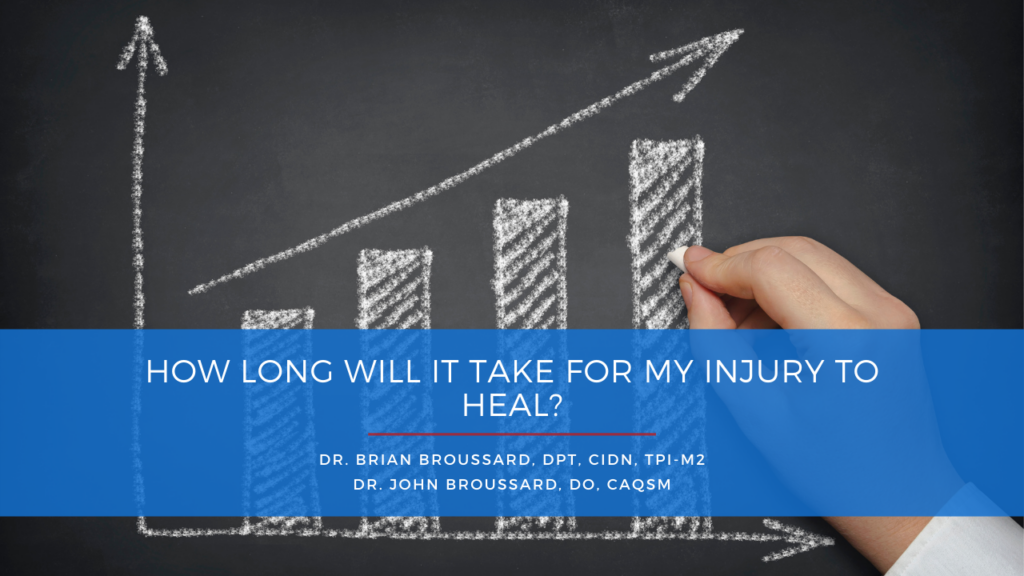How Long Will It Take My Injury To Heal?
“How long will it take for this to heal” is the golden question that the majority of people in pain or injury are thinking about and asking about. What we’d like to do is to discuss the stages of healing that we always think about when answering this question and when deciding on treatment plans with our patients.
When an injury comes into your life unexpected, the first thing you want to know is “how long will it take until I can get back to doing x, y, and z.” The difficult part of injuries and tissue damage is that there are multiple variables that go into that answer. Some of those variables are your age, severity of the injury, the tissue that was damaged, your daily habits, smoking, drinking, sleeping, and even nutrition. All of these things can impact the rate of healing, overall healing potential, and how quickly you can return to your activity of choice. So, let’s discuss some general guidelines or time frames of normal tissue healing.
What Are The Phases of Tissue Healing?
The “Moment of Injury” Phase
Some call this the bleeding phase and it is the initial first step whenever you have an injury, an ankle sprain, torn quad muscle, ACL tear or rotator cuff injury. This is easily comparable to when you accidentally cut your arm or leg and there’s bleeding that happens right away. But, you’ll notice that the cut and the bleeding eventually stops. Your body’s “first responders” get sent to the area to do damage control and patchwork. Not long after this happens is when your body is begins to transition to the next phase.
The Inflammatory Phase
This phase is actually quite obvious if you’ve ever had an injury or bumped your toe or your knee on something. There’s usually some level of swelling in the part of the inflammation phase, which is a natural response to an injury. However, the body is smart and it doesn’t want this phase to last too long, so this usually lasts for about 0-6 days. Now, your body is bringing blood and good chemicals to the area, such as histamine, that allows cells such as white blood cells to enter the damaged area. The arrival of these initial cells helps with the removal of debris (dead tissue cells) and it also helps to clean the area of bacteria so the body can continue the healing process of the injured tissue.
Proliferation Phase
The proliferation phase is the next step and usually lasts from about Day 4 to 24 days after the initial injury. During this phase, your body is starting to rebuild and place “scaffolding” up in and around the injured area. This involves cells called fibroblasts, which place immature cells or types of tissue in a random fashion of the injured site. You can think about taking out raw spaghetti noodles and putting them on the ground – you can imagine they would be laid out in all different directions. This type of tissue is derived from collagen and helps provide structure to your body, but it’s important to know that this type of collagen is not as functional and strong as the collagen in normal/healthy tissue. When we look at an injured tendon, for example, on diagnostic ultrasound, we may see that this tendon is slightly smaller in size as compared to the healthy side, looks cloudy, or it may even look thicker.
Remodeling or Maturation Phase
Yes, your tissue should mature, just like your kiddos should mature as well. The fourth and final phase of tissue healing is the remodeling or maturation phase. This phase can last from three weeks to two years after the initial injury. This phase Is all about getting that immature type-III collagen to transform or be converted into more of a functional and mature type of collagen: type-I collagen. So, let’s revisit the spaghetti example. If you have your spaghetti noodles on the ground and they’re all in haphazard directions – they aren’t in line. If you were to take your hand and roll it over these raw spaghetti noodles, they would start to come together in a uniform fashion or parallel with each other. This is an example of turning immature collagen, that is all put together in random forms and non-functional, into a more functional and uniform type of tissue. This type-I collagen Has an orientation of the spaghetti noodles inside of the box.
Main Takeaway
So, by now you can see that phases of healing can vary in range and in different individuals. These stages of healing can be different depending on the severity of the injury, the location, the tissue involved, etc. When answering this question or when forecasting a prognosis, we always think about this process. We know that this is something most patients have no clue about, but it’s something that can help each person understand the process of healing and to at least appreciate there is a reason for each decision we make.
Be on the lookout for another blog discussing healing rates in different tissues and injuries!
If you’re dealing with an injury, old or new, give us a call or fill the form on our website to talk with a specialist.

